Page 60 of 165
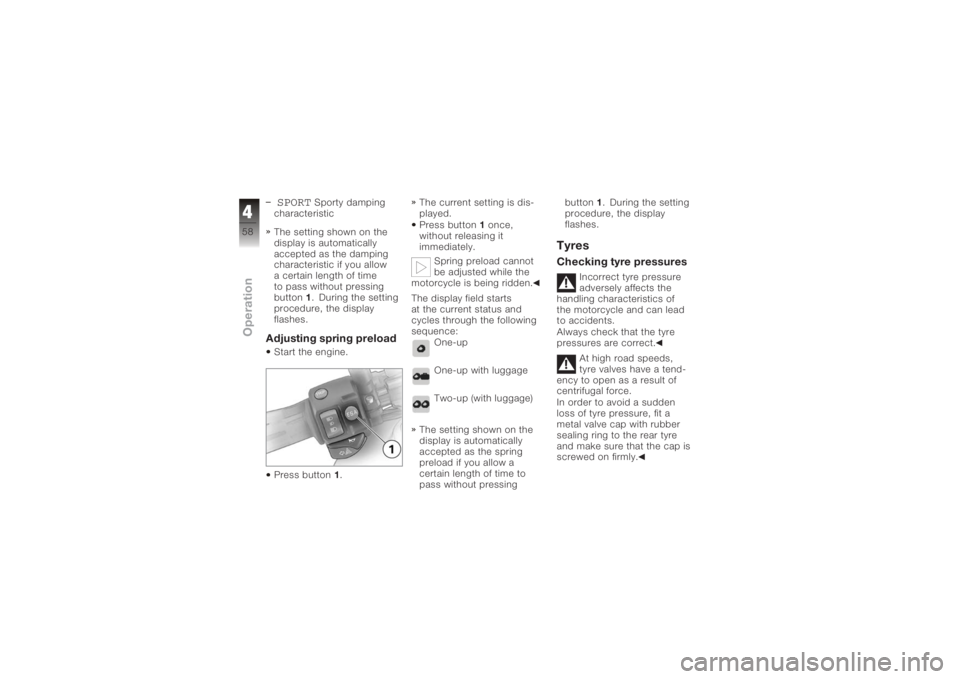
SPORT
Sporty damping
characteristic
The setting shown on the
display is automatically
accepted as the damping
characteristic if you allow
a certain length of time
to pass without pressing
button 1. During the setting
procedure, the display
flashes.
Adjusting spring preloadStart the engine.
Press button 1. The current setting is dis-
played.
Press button
1once,
without releasing it
immediately.
Spring preload cannot
be adjusted while the
motorcycle is being ridden.
The display field starts
at the current status and
cycles through the following
sequence:
One-up
One-up with luggage
Two-up (with luggage)
The setting shown on the
display is automatically
accepted as the spring
preload if you allow a
certain length of time to
pass without pressing button
1. During the setting
procedure, the display
flashes.
TyresChecking tyre pressures
Incorrect tyre pressure
adversely affects the
handling characteristics of
the motorcycle and can lead
to accidents.
Always check that the tyre
pressures are correct.
At high road speeds,
tyre valves have a tend-
ency to open as a result of
centrifugal force.
In order to avoid a sudden
loss of tyre pressure, fit a
metal valve cap with rubber
sealing ring to the rear tyre
and make sure that the cap is
screwed on firmly.
458zOperation
Page 61 of 165
Incorrect tyre pressure
reduces the operating
life of the tyres.
Always check that the tyre
pressures are correct.
Check that tyre pressures
are correct as per the data
below.
Front wheel, tyre pressure
2.5 bar (When cold)
Rear wheel, tyre pressure
2.9 bar (When cold)
If tyre pressure is too low: Correct the tyre pressures.
459zOperation
Page 64 of 165
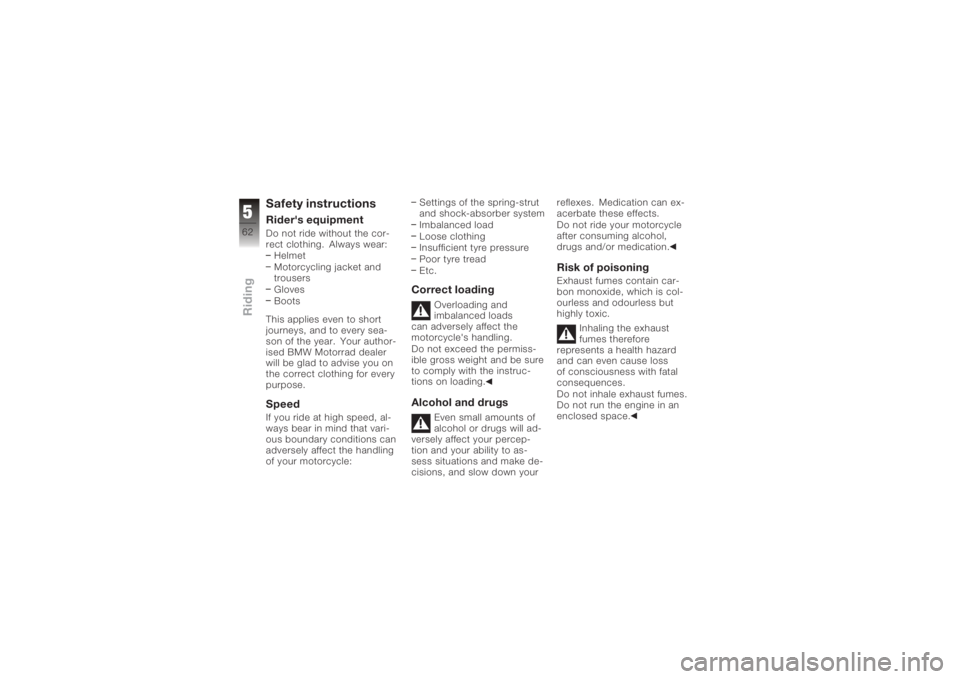
Safety instructionsRider's equipmentDo not ride without the cor-
rect clothing. Always wear:Helmet
Motorcycling jacket and
trousers
Gloves
Boots
This applies even to short
journeys, and to every sea-
son of the year. Your author-
ised BMW Motorrad dealer
will be glad to advise you on
the correct clothing for every
purpose.SpeedIf you ride at high speed, al-
ways bear in mind that vari-
ous boundary conditions can
adversely affect the handling
of your motorcycle: Settings of the spring-strut
and shock-absorber system
Imbalanced load
Loose clothing
Insufficient tyre pressure
Poor tyre tread
Etc.
Correct loading
Overloading and
imbalanced loads
can adversely affect the
motorcycle's handling.
Do not exceed the permiss-
ible gross weight and be sure
to comply with the instruc-
tions on loading.
Alcohol and drugs
Even small amounts of
alcohol or drugs will ad-
versely affect your percep-
tion and your ability to as-
sess situations and make de-
cisions, and slow down your reflexes. Medication can ex-
acerbate these effects.
Do not ride your motorcycle
after consuming alcohol,
drugs and/or medication.
Risk of poisoningExhaust fumes contain car-
bon monoxide, which is col-
ourless and odourless but
highly toxic.
Inhaling the exhaust
fumes therefore
represents a health hazard
and can even cause loss
of consciousness with fatal
consequences.
Do not inhale exhaust fumes.
Do not run the engine in an
enclosed space.
562zRiding
Page 66 of 165
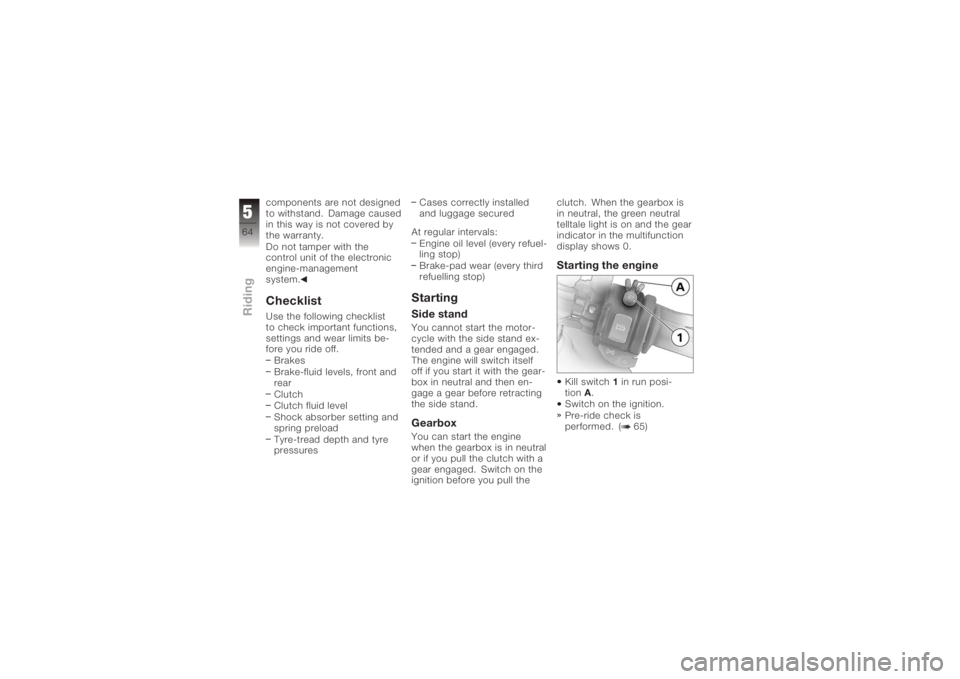
components are not designed
to withstand. Damage caused
in this way is not covered by
the warranty.
Do not tamper with the
control unit of the electronic
engine-management
system.ChecklistUse the following checklist
to check important functions,
settings and wear limits be-
fore you ride off.Brakes
Brake-fluid levels, front and
rear
Clutch
Clutch fluid level
Shock absorber setting and
spring preload
Tyre-tread depth and tyre
pressures Cases correctly installed
and luggage secured
At regular intervals: Engine oil level (every refuel-
ling stop)
Brake-pad wear (every third
refuelling stop)
StartingSide standYou cannot start the motor-
cycle with the side stand ex-
tended and a gear engaged.
The engine will switch itself
off if you start it with the gear-
box in neutral and then en-
gage a gear before retracting
the side stand.GearboxYou can start the engine
when the gearbox is in neutral
or if you pull the clutch with a
gear engaged. Switch on the
ignition before you pull the clutch. When the gearbox is
in neutral, the green neutral
telltale light is on and the gear
indicator in the multifunction
display shows 0.
Starting the engineKill switch
1in run posi-
tion A.
Switch on the ignition.
Pre-ride check is
performed. ( 65)
564zRiding
Page 70 of 165
Avoid low engine speeds at
full load.
Do not omit the first inspec-
tion after 500 - 1200 km.Brake padsNew brake pads must "bed
down" and therefore do not
achieve their optimum friction
levels during the first 500 km.
You can compensate for this
initial reduction in braking ef-
ficiency by exerting greater
pressure on the levers.New brake pads can ex-
tend stopping distance
by a significant margin.
Apply the brakes in good
time.TyresNew tyres have a smooth
surface. This must be
roughened by riding in a
restrained manner at various
heel angles until the tyres are run in. This running in
procedure is essential if the
tyres are to achieve maximum
grip.
Tyres do not have their
full grip when new and
there is a risk of accident at
extreme angles of heel.
Avoid extreme angles of
heel.
568zRiding
Page 83 of 165
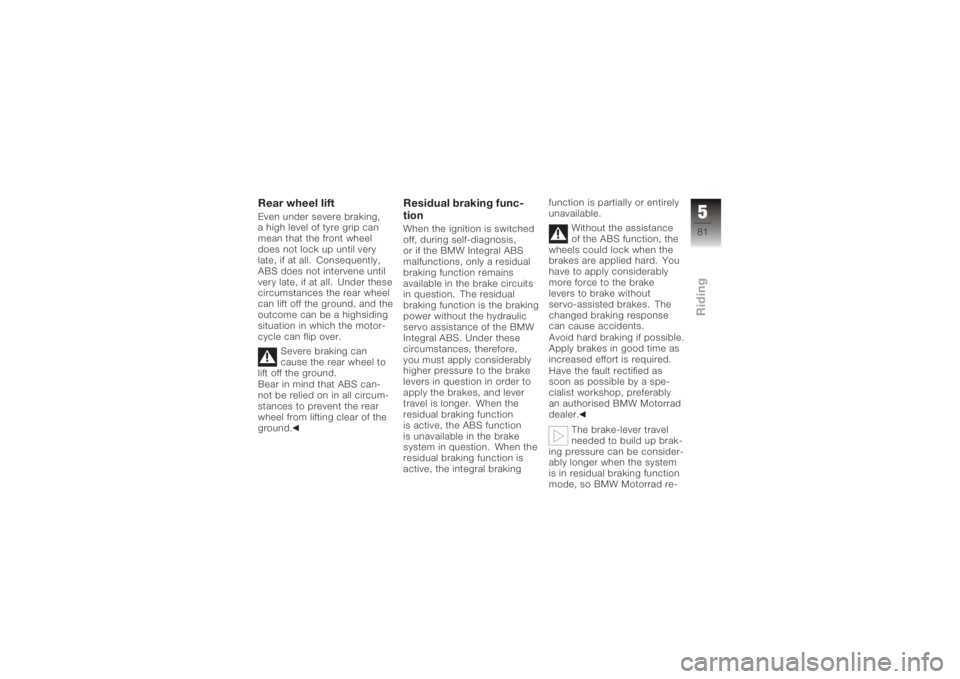
Rear wheel liftEven under severe braking,
a high level of tyre grip can
mean that the front wheel
does not lock up until very
late, if at all. Consequently,
ABS does not intervene until
very late, if at all. Under these
circumstances the rear wheel
can lift off the ground, and the
outcome can be a highsiding
situation in which the motor-
cycle can flip over.Severe braking can
cause the rear wheel to
lift off the ground.
Bear in mind that ABS can-
not be relied on in all circum-
stances to prevent the rear
wheel from lifting clear of the
ground.
Residual braking func-
tionWhen the ignition is switched
off, during self-diagnosis,
or if the BMW Integral ABS
malfunctions, only a residual
braking function remains
available in the brake circuits
in question. The residual
braking function is the braking
power without the hydraulic
servo assistance of the BMW
Integral ABS. Under these
circumstances, therefore,
you must apply considerably
higher pressure to the brake
levers in question in order to
apply the brakes, and lever
travel is longer. When the
residual braking function
is active, the ABS function
is unavailable in the brake
system in question. When the
residual braking function is
active, the integral braking function is partially or entirely
unavailable.
Without the assistance
of the ABS function, the
wheels could lock when the
brakes are applied hard. You
have to apply considerably
more force to the brake
levers to brake without
servo-assisted brakes. The
changed braking response
can cause accidents.
Avoid hard braking if possible.
Apply brakes in good time as
increased effort is required.
Have the fault rectified as
soon as possible by a spe-
cialist workshop, preferably
an authorised BMW Motorrad
dealer.
The brake-lever travel
needed to build up brak-
ing pressure can be consider-
ably longer when the system
is in residual braking function
mode, so BMW Motorrad re-
581zRiding
Page 140 of 165
BrakesFront brake, typeHydraulically operated twin disc brake with 4-
piston fixed calipers and floating brake discs
Front brake pads, material Sintered metal
Rear brake, type Hydraulically operated disc brake with
2-piston floating caliper and fixed disc
Rear brake pads, material Organic materialWheels and tyresFront wheel, typeCast aluminium, MT H2
Front wheel, rim size 3.50" x 17"
Front wheel, tyre designation 120/70 ZR17
Rear wheel, type Cast aluminium, MT H2
Rear wheel, rim size 5.50" x 17"
with OE Sports wheel: 6.00" x 17"
Rear wheel, tyre designation 180/55 ZR17
with OE Sports wheel: 190/50 ZR17
Tyre pressures
Front wheel, tyre pressure 2.5 bar, When cold
Rear wheel, tyre pressure 2.9 bar, When cold
9138zTechnical data
Page 159 of 165
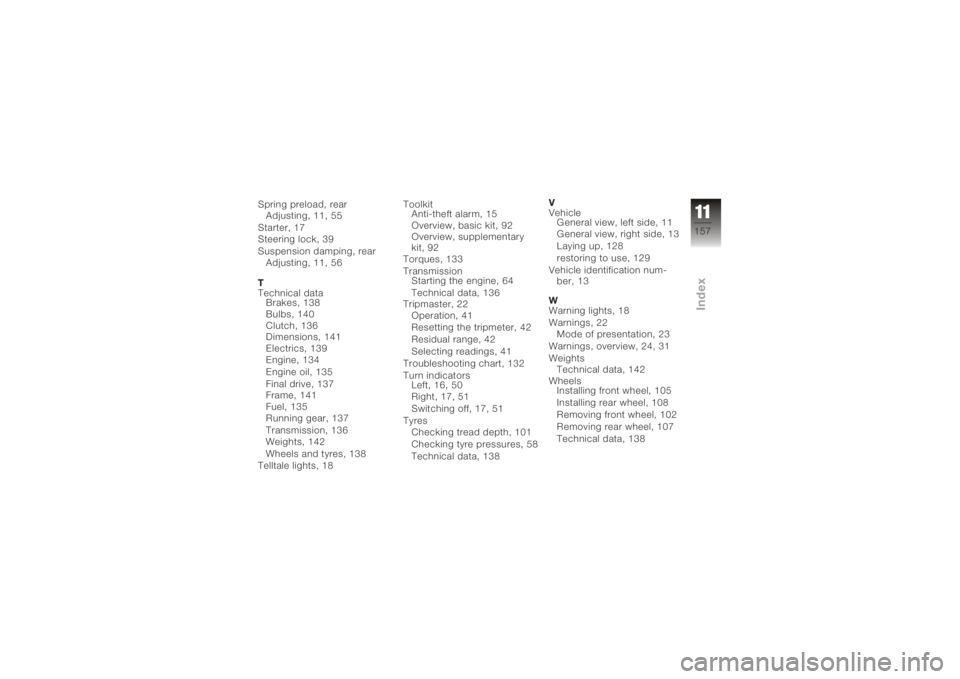
Spring preload, rearAdjusting, 11, 55
Starter, 17
Steering lock, 39
Suspension damping, rear Adjusting, 11, 56
T
Technical data Brakes, 138
Bulbs, 140
Clutch, 136
Dimensions, 141
Electrics, 139
Engine, 134
Engine oil, 135
Final drive, 137
Frame, 141
Fuel, 135
Running gear, 137
Transmission, 136
Weights, 142
Wheels and tyres, 138
Telltale lights, 18 Toolkit
Anti-theft alarm, 15
Overview, basic kit, 92
Overview, supplementary
kit, 92
Torques, 133
Transmission Starting the engine, 64
Technical data, 136
Tripmaster, 22 Operation, 41
Resetting the tripmeter, 42
Residual range, 42
Selecting readings, 41
Troubleshooting chart, 132
Turn indicators Left, 16, 50
Right, 17, 51
Switching off, 17, 51
Tyres Checking tread depth, 101
Checking tyre pressures, 58
Technical data, 138 V
Vehicle
General view, left side, 11
General view, right side, 13
Laying up, 128
restoring to use, 129
Vehicle identification num- ber, 13
W
Warning lights, 18
Warnings, 22 Mode of presentation, 23
Warnings, overview, 24, 31
Weights Technical data, 142
Wheels Installing front wheel, 105
Installing rear wheel, 108
Removing front wheel, 102
Removing rear wheel, 107
Technical data, 138
11157zIndex